Tokina AT-X 17-35mm f/4 Pro FX Lens Review
Tokina AT-X 17-35mm f/4 Pro FX Performance
At 17mm and maximum aperture, sharpness just reaches good levels in the centre of the frame, and can only be considered fair towards the edges. Stopping the lens down improves sharpness dramatically and peak performance is achieved at f/8 where sharpness in the centre is outstanding and excellent towards the edges of the frame.With the lens zoomed to 24mm. Sharpness at maximum aperture drops off further and can only be considered fair across the frame. Images have a slight hazy appearance, which is often a sign of spherical aberrations reducing sharpness. As is the case at 17mm, stopping down improves sharpness dramatically, reaching the same lofty heights of excellence at f/8.
Finally, at 35mm, the same issues with spherical aberrations occurs at maximum aperture, resulting in fair sharpness in the centre and fairly poor sharpness towards the edges of the frame. Peak sharpness for 35mm is achieved between f/8 and f/11. At f/11 sharpness is excellent across the frame.
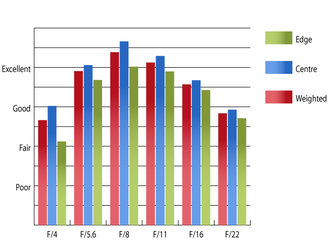 Resolution at 17mm | 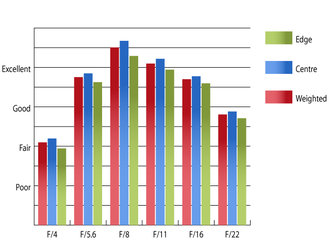 Resolution at 24mm | |
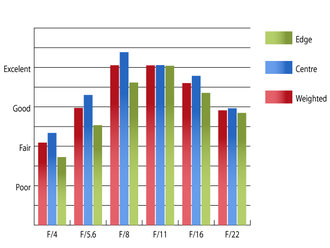 Resolution at 35mm | How to read our charts The blue column represents readings from the centre of the picture frame at the various apertures and the green is from the edges. Averaging them out gives the red weighted column. |
Chromatic aberrations are kept well under control throughout the zoom range, remaining well under one pixel width towards the edges of the frame. This low level should pose few issues, even in big enlargements, or harsh crops from the edges of the frame.
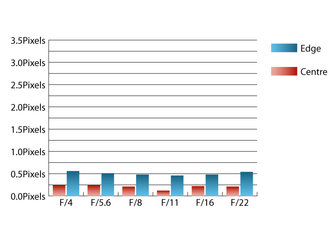 Chromatic aberration at 17mm | 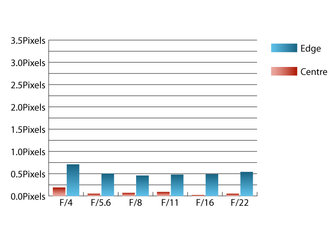 Chromatic aberration at 24mm | |
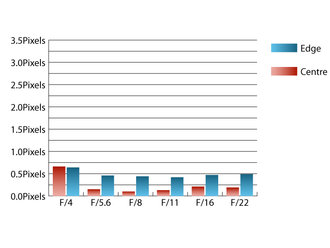 Chromatic aberration at 35mm | How to read our chartsChromatic aberration is the lens' inability to focus on the sensor or film all colours of visible light at the same point. Severe chromatic aberration gives a noticeable fringing or a halo effect around sharp edges within the picture. It can be cured in software.Apochromatic lenses have special lens elements (aspheric, extra-low dispersion etc) to minimize the problem, hence they usually cost more. For this review, the lens was tested on a Canon EOS 1Ds Mark III using Imatest. |
Falloff of illumination towards the corners of the frame is more pronounced at 17mm than 35mm. At 17mm the corners are 2.09 stops darker than the image centre at f/4, and this drops to the corners only being 0.3 stops darker at 35mm and f/4. Visually uniform illumination is achieved by f/8 at 17mm and by f/5.6 at 35mm.
Distortion is very low for an ultra wide zoom lens. At 17mm only 3.4% barrel distortion is present, which is replaced by 0.226% pincushion at 35mm. The distortion pattern is uniform across the frame, which should make corrections in image editing software easy to apply if straight lines are paramount.
A petal-shaped hood is supplied with the lens, which does a reasonable job of shading the front element from extraneous light. The hood attachs to the lens in the same direction as the lens is mounted on Canon cameras, which can cause issues when removing the lens from the camera. At 17mm, this lens is a little prone to flare, especially with bright sources of light towards the edges of the frame. Contrast remains good, even when shooting into the light.
Add your message
Login required
Please login here or if you've not registered, you can register here. Registering is safe, quick and free.
Please login here or if you've not registered, you can register here. Registering is safe, quick and free.
photodo Stats
1102 lenses
428 MTF tests
74 in-depth photodo reviews
100+ users join each day
Help the lens community by reviewing or rating a lens today via our lens search
428 MTF tests
74 in-depth photodo reviews
100+ users join each day
Help the lens community by reviewing or rating a lens today via our lens search
Latest Lens Reviews
- Chinon 28mm f/2.8 Vintage Lens Review
- Canon EF 70-200mm f/4L IS II USM Lens Review
- Samyang AF 85mm f/1.4 EF Review
- Sigma 70mm f/2.8 DG Macro Art Review
- Samyang AF 24mm f/2.8 FE Review
- Meike 50mm f/1.7 Review
- Tamron 70-210mm f/4 Di VC USD Review
- Lensbaby Burnside 35mm f/2.8 Review
- Asahi Super Takumar 50mm f/1.4 Review
- Asahi Super-Multi-Coated Takumar 135mm f/3.5 Review
